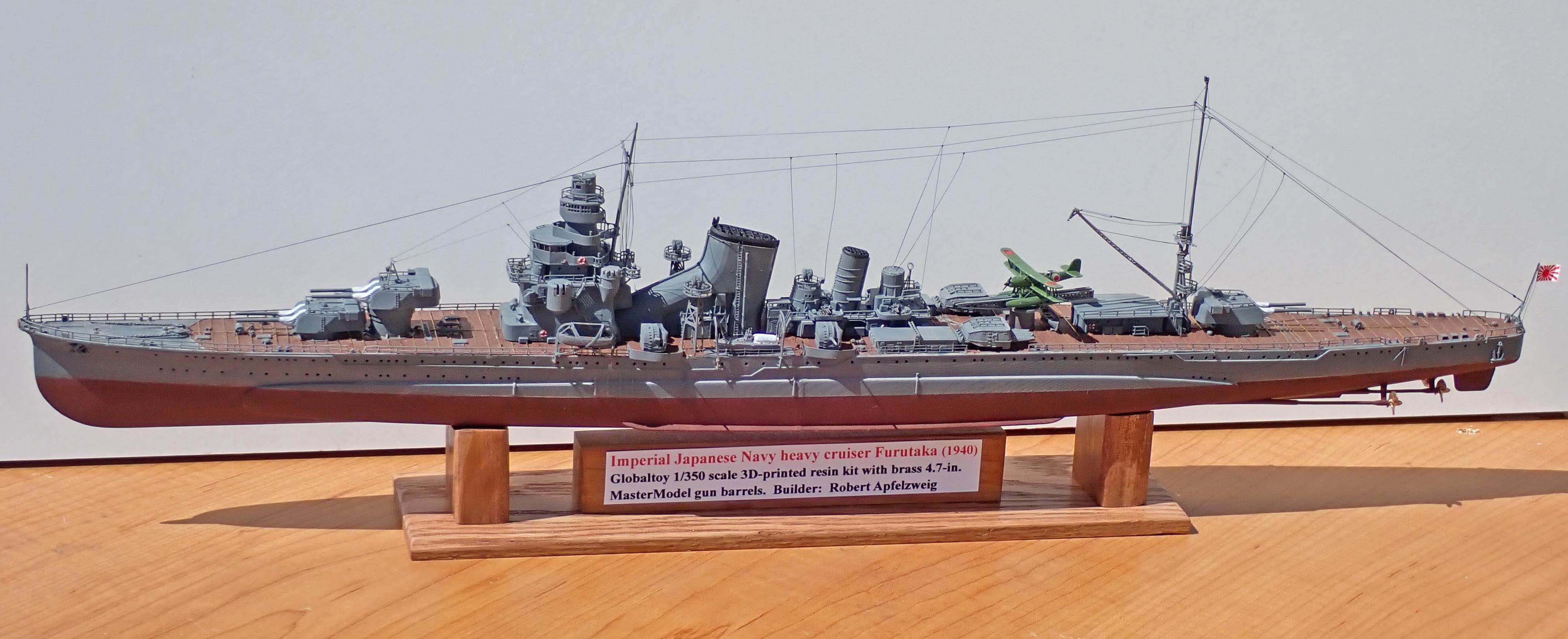
1/350 IJN Heavy Cruiser Furutaka 1940 (Globaltoy 3D printed)
|
by Robert Apfelzweig |

1/350 IJN Heavy Cruiser Furutaka 1940 (Globaltoy 3D printed)
This was my first 3D-printed ship model, in my preferred scale, obtained from our favorite online auction site just three weeks after ordering. The model comes in a loud orange color, with fore and aft full hull halves and most major parts (turrets/guns, bridge, funnels, mainmast structure, etc.) in one piece each. Smaller parts are nearly buried amid numerous narrow printing sprues and require careful snipping off of these to free the desired part. These 3D-printed parts are generally stronger than their attachment sprues, but sometimes are too flexible, almost rubbery, as is the case with the masts and gun barrels for the four twin 25mm and two 13.2 mm double AA mounts. Also, especially on the ends of the hull sections, there are many small resin "pegs" that must be sanded off or removed with a sharp blade. The model itself seems to be based on images of the War Thunder video game version of this ship, so historical accuracy is suspect to some degree, though the bridge, in one piece, is exceptionally well-made and clear of sprue residue. The main deck railing is included as part of the resin casting, as are superstructure rails, ladders and even sea ladders (individual rungs), though I replaced some short rail sections amidships with spare railing from Gold Medal Models. The kit has no flagstaffs for the bow and stern, so I fashioned these from suitable brass wire, which also was used for the mainmast, since the resin piece was warped and flimsy (the resin foremast was better in this respect and did not require replacement). The various superstructure sections fit well onto the flush main deck, as there are holes in the bottoms of these pieces that align with pegs in the main deck. This deck also has raised lines for the transverse brass strips that covered them, and I had a set of these from Northstar that I used; attachment was tedious but worth it. The 4.7-in. gun barrels for the four heavy AA guns were attached to the gunhouses and seemed oversized, so I replaced them with Master Model 5-in. .25 cal barrels of the same length. The 8-in. guns for the three turrets (the two barrels and turrets are one piece, with blastbags) had tiny depressions in their muzzle centers rather than realistically hollowed out ends, but these were suitable bore sites for drilling them out. Lastly, one needs to understand how this ship was constructed, as there are no assembly instructions whatsoever; online photos and diagrams are helpful, especially for the rigging, including those from a similar kit from 3D Wild (which boasts a considerable brass barrel and photoetch set, though no blast bags). I completed the model with spare decals for the flag and floatplane, and a brass chrysanthemum crest for the bow. Paint, conveniently, was from Tamiya: red-brown for the deck, hull red for the lower hull, and Kure grey for nearly everything else.The Furutaka was one of a class of four (many naval historians say two similar classes of two ships each) built in the mid-1920s and were the IJN's first modern heavy cruisers, though their main armament initially consisted of seven 7.9-in. guns in single turrets. All the ships of this class underwent major rebuilds in the late 1930s to arrive at the general appearance of the Furutaka in this kit. This particular warship was the third Japanese heavy cruiser to be sunk by the US Navy, in this case at the Battle of Cape Esperance during a night action 11-12 October, 1942 as part of the numerous Guadalcanal sea battles. Consequently, the Furutaka never underwent any further AA upgrades or radar installation.
The last photo shows the kit dry-fitted before gluing.
